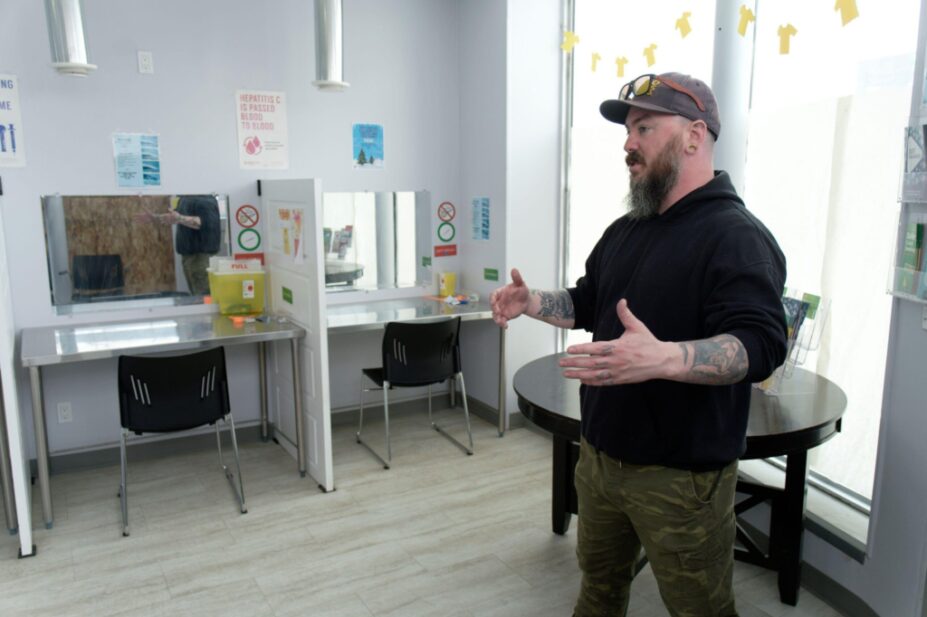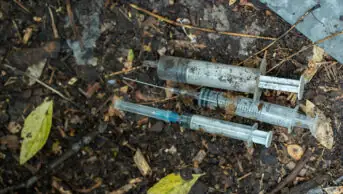
The Canadian Press / Alamy Stock Photo
On 23 September 2023, item seven on the agenda for a meeting of the Greater Glasgow Integration Joint Board made history in the UK.
Integration joint boards in Scotland bring together health boards and local authorities to plan and deliver health and social care in their area, and at the September meeting the Glasgow board approved the creation of the UK’s first drug consumption room.
Referred to in the papers for the meeting as a “safer drug consumption facility”, the Scottish government has said it will provide up to £2.35m annually to support it from when it is expected to open in early 2024.
Approval for the drug consumption room in Glasgow has been a long time coming. Proposals were first submitted to the board in 2016, and a business case for such a facility was approved in 2017, but its introduction stalled because of a significant issue — that people using the centre would be breaking the law.
In the six years since the initial joint board decision was taken, two significant factors have come into play.
Firstly, the already disproportionately high number of deaths from illegal drug use in Scotland increased further still, with figures peaking in 2020, when 1,339 deaths related to drug misuse were recorded. At the time, Greater Glasgow and Clyde Health Board area had the highest number of deaths from drug misuse out of any area in Scotland, at 30.8 deaths per 100,000 people.
Secondly, following the initial approval of the safer drug facility business case, NHS Greater Glasgow and Clyde (NHS GGC) and Glasgow City Council sought legal counsel, including from Scotland’s Lord Advocate, on a prosecution policy for people who would be using illegal drugs at such a facility.
In Scotland, the Lord Advocate heads the system of criminal prosecution. Although they are a government minister, their role in terms of prosecutions is separate from other members of the government.
While no policy was forthcoming at the time, Glasgow City Health and Social Care Partnership approached a new Lord Advocate, Dorothy Bain, in 2022, with revised proposals that would see the drug consumption facility provided alongside a range of specialist harm reduction and treatment and care services, with pathways into longer-term recovery.
On 11 September 2023, the Lord Advocate confirmed that she would be prepared to publish a prosecution policy saying that it would not be in the public interest to prosecute users of a safer drug consumption facility in terms of section 5(2) of the Misuse of Drugs Act 1971 for simple possession offences committed within the confines of the facility.
With this legal guarantee, the joint board could give the go-ahead for the consumption room.
The case for
Known as overdose prevention centres, drug consumption rooms or supervised injecting centres, the idea behind such facilities is the same: to provide a safe environment where drug users can consume drugs, bought elsewhere, in the presence of trained healthcare professionals, in clean and hygienic environments, thus reducing the risk of overdose and infectious diseases while offering support and access to healthcare services.
A literature review of evidence for their efficacy, published in the journal Risk Management and Healthcare Policy in November 2021, asserts that such facilities were established in Switzerland in the 1980s, with other European countries following suit. Exact numbers are not available, but the researchers estimate that there are now more than 100 such facilities in existence around the world.
The first facility to open with medical supervision, and the first in the English-speaking world, was the Medically Supervised Injecting Centre in downtown Sydney, Australia. It opened in 2001 and says that it has subsequently overseen 1.26 million injections, managed 11,205 overdoses, and referred 22,000 people to further care and treatment. The centre has recorded no fatalities in the 22 years it has been operating.
Put simply, when a safer place to inject drugs is provided, the associated short-term harms are greatly reduced
Researchers on the study of data from the Medically Supervised Injecting Centre
A study of data from the centre, published in October 2022, found that less than 1% of injections have resulted in adverse incidents, with the researchers concluding: “Put simply, when a safer place to inject drugs is provided, the associated short-term harms are greatly reduced. The longer-term harms are also reduced with increased access to services, including drug treatment, hepatitis C care and smoking cessation.”
The researchers who carried out the literature review of evidence on consumption rooms reported that the best evidence on such centres’ work comes from the Sydney facility and a supervised drug injection facility called Insite in Vancouver, Canada.
Evidence from Insite, published in the Canadian Medical Association Journal in 2010, shows that between 2 and 12 deaths were averted annually because of the facility; there was a 70% decrease in the likelihood that users will share needles; there was a statistically significant fall in the number of vehicle break-ins and theft in the area surrounding the facility; and there was a decrease in public injecting and a lower prevalence of drug-related litter nearby.
The focus of different safer injecting facilities around the world varies depending on local circumstance. In Scotland, Carole Hunter, who was until recently the lead pharmacist for alcohol and drug services at NHS GGC, and still works for the health board as a consultant, says that, despite the high number of drug deaths in Scotland, the Glasgow facility was not initially proposed in response to these deaths.
Rather, Hunter says, it came about following a report published by NHS GGC, entitled ‘Taking away the chaos’, which was produced in 2016 as a result of a significant outbreak of HIV among people who injected drugs in the city.
Hunter says that the initial proposal was for a standalone service, but updated proposals that mean the facility will be co-located with a wider healthcare offering, which will include an enhanced drug treatment service, alcohol and drug recovery services, and blood borne viruses and sexual health services, as well as the slightly smaller scale of the proposed centre, probably helped with getting approval for the facility over the line.
In the area where the centre will open, she says there are some “really horrific areas of injecting”, and that it is vitally important that the local community is involved in ongoing discussions about the facility and how it will operate.
The Royal Pharmaceutical Society (RPS) has said that it supports the introduction of supervised drug consumption rooms (SDCRs) as part of a wider strategy to reduce harm and prevent drug deaths.
Following the approval of the Glasgow site, Laura Wilson, RPS director for Scotland, said: “Pharmacists, and pharmacy teams, already play a big role in supporting and providing treatment to people who use drugs, as well as offering harm reduction services and advice. It is vital that there is pharmacy input into any SDCRs which are established.”
In 2021, the Faculty of Public Health published an open letter calling on the UK government to amend the Misuse of Drugs Act to permit the use of overdose prevention centres.
Alongside the RPS, the letter had a long list of signatories, including the British Medical Association Board of Science, the Academy of Medical Royal Colleges and South Yorkshire Police.
The case against
Although the evidence for their efficacy is convincing, in the UK, the government has repeatedly rejected any suggestions of opening safe drug consumption facilities. In 2017, the government opposed recommendations made by the Advisory Council on the Misuse of Drugs to consider opening such facilities in areas with a concentration of injected drug use, saying that “people using drugs they have bought on the street is not part of a structured treatment plan”.
In 2020, the UK government again opposed progress in this area, saying it would not follow a recommendation made by the House of Commons Scottish Affairs Committee to change legislation to allow for a pilot of a safe consumption facility to take place in Scotland.
The government has rejected proposals for safer injection facilities several times since 2016, under multiple home secretaries. The views of government ministers have varied over time, but ultimately no sanction from the UK government has been forthcoming.
For instance, in 2018, then Home Office minister Victoria Atkins told a Westminster Hall debate that the government had “no intention of introducing drug consumption rooms, nor do we have any intention of devolving the United Kingdom policy on drug classification and the way in which we deal with prohibited drugs to Scotland”.
But, in 2019, then Home Office minister Kit Malthouse told the House of Commons Scottish Affairs Committee that he had an “open mind” about the opening of supervised drug consumption rooms in Scotland.
My own main reservation is that, to use the facility, people have to buy drugs illegally, and opening the centre is effectively rubber-stamping that
John Mason, MSP for Glasgow Shettleston
John Mason, MSP for Glasgow Shettleston — the Scottish Parliament constituency where the safe consumption room will sit — says the area has a history of drug use, with injecting often being carried out in public areas.
“The biggest centre in Glasgow for selling prams is nearby, which obviously attracts a lot of families with small children, and that has had problems,” he says. “And a supermarket has had to remove billboards because people were hiding their drugs behind them. So, the new facility could stop this, but residents are also concerned that it could bring drug users and dealers to the area.”
“There has been some opposition from residents, and certainly scepticism. Some members of the public are generally opposed, and others have specific reservations,” he adds.
“My own main reservation is that, to use the facility, people have to buy drugs illegally, and opening the centre is effectively rubber-stamping that.”
Exactly how the facility will work is yet to be established, and in her letter to the Glasgow joint board agreeing to produce a prosecution policy for people at the facility, the Lord Advocate added that it would not be “appropriate” for her to issue a prosecution policy for people heading to or from the drug consumption rooms, or to cover allegations of the supply of drugs.
While welcoming the proposals overall, Catriona Matheson, former chair of the Scottish government’s drug deaths taskforce, also has concerns about the Glasgow facility.
“Due to a change in patterns of drug-taking, I do wonder if we’ve missed the boat with this a little bit,” she says. “The situation now in Scotland is that there are not many cities that experience a lot of street injecting, apart from Glasgow, and possibly Dundee.”
“Patterns of drug use change and now smoking, both heroin and cocaine, is becoming increasingly common,” she says.
She adds that drug users who inject often do so at home, so the numbers of people using the safe consumption room once it opens will be interesting to see. She also cautions that the facility has only been approved as a pilot, and says that evidence from other sites shows that it can take time for drug users to want to use such facilities, which may not happen before an evaluation is carried out.
Our verdict
The view of the medical and healthcare professions and, even in some cases, the police, is clear. Safer drug consumption facilities can help reduce the risk of harm to drug users and encourage the use of broader treatment for addiction, as well as provide a safer environment for those living and working in the vicinity of the centre.
In Glasgow, the proposals for the pilot scheme, which the Lord Advocate has said must include a “careful evaluation of the facility and its potential impact” will be closely watched by healthcare professionals and politicians alike. Whether the Glasgow site will be the first of several such centres in the UK, or if the experience rules out any further facilities around the country, remains to be seen.


